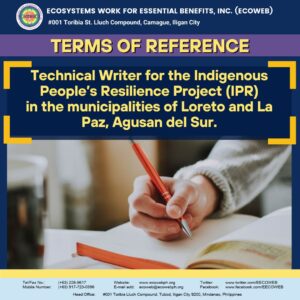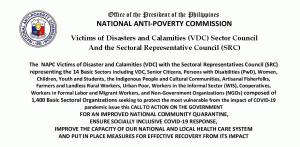Thousands of Abaca farmers affected
Tens of thousands of small farmers in the Philippines producing abaca natural fiber used in the production of teabags and surgical masks used in fighting COVID-19 were devastated by Typhoon Goni (Rolly in the Philippines). The super-typhoon made landfall to the province of Catanduanes in the Bicol Region early in the morning of November 1, 2020.
Catanduanes and the Bicol Region, respectively, are the leading province and region, in abaca fiber production in the Philippines. The province of Catanduanes alone produces about 30 percent of the natural fiber produced in the Philippines in 2019.
Decline in Abaca production
The Business Mirror, a national daily, reported on November 3, that according to PhilFIDA Executive Director Kennedy T. Costales, the total abaca output this year is expected to decline by 30 percent to a 20-year low of 50,000 metric tons (MT) due to impact of the series of typhoons that hits abaca-growing provinces. PhilFIDA or Philippine Fiber Industries Development Authority is the country’s leading agency supervising and regulating the fiber industry to which abaca fiber is among the champion export product in the last 100 years.
Latest data from PhilFIDA showed that abaca output from January to August 2020 is down by 27 percent to 35,130.075 MT from 48,170.825 MT recorded in the same period of last year. The decline was attributed to the impact of typhoons during the period and the COVID-19 pandemic.
Of the total abaca output during the eight-month period, about 10,213.2 MT or 29 percent was produced by Catanduanes province alone.
Impact to Poverty
Governor Joseph Cua of Catanduanes, quoted in a report by Business Mirror, said that “the damage caused by Rolly to the island-province was estimated to have reached P400 million already. Abaca is the main product of the province and generates for it P150 million worth of revenues every month or at least P1.8 billion a year.”
Poverty incidence in the province of Catanduanes was estimated at 19.4% of its population in 2018 which is slightly higher than the national average pegged at 16.1% in the same year. The poorest province in the Philippines has poverty incidence pegged at 74.3 percent.
“The relatively low poverty incidence in Catanduanes, a province visited by typhoon at least twice every year, could be attributed to the stable income of the abaca farming families,” said
Regina “Nanette” Salvador-Antequisa, the Sectoral Representative (SR) of the Victims of Disasters and Calamities (VDC) sector to the National Anti-Poverty Commission (NAPC).
“It is remarkable that Catanduanes, with its annual typhoon event retained its low-level poverty incidence while Lanao del Sur, a province only visited by typhoon at least once in every 10 years remain to be the poorest province in the country,” added SR Nanette Antequisa who is also the Executive Director of ECOWEB, a national NGO based in Mindanao.
Lanao del Sur is among the top 10 provinces in the Philippines that produces abaca fiber but poverty is lingering in the province. “Unlike Catanduanes, the vast abaca farms in Lanao del Sur are situated in big land-holdings and inter-cropped with coconut in the plantations thus it has relatively low impact to poverty,” said Carino Antequisa, the program development advisor of ECOWEB. “In addition, Lanao del Sur experience protracted conflict for many years.”
Need to help Abaca farmers recover from impact of typhoon Goni
“The tree of life for many is coconut. But for thousands of abacaleros and artisans of the Bicol region, abaca provides the essential of life…an income from stripping to twisting to braiding to knotting to weaving to crocheting for products used for homes and fashion for industrial uses in automobiles or tea bags or even for currency,” said Mediatrix “Tita Med” Villanueva, a philanthropist whose family enterprise in Bicol brings high quality abaca products in the national and international market.
“The farmers and all the affected need help to expedite building back their lives and restoring their communities,” said Tita Med who also represents the humanitarian organization, Simon of Cyrene, in the NAPC-VDC Sectoral Council. But Tita Med appeals NOT only 3 kilos of rice, sardines and noodles, but for sufficient assistance of rice and nutritious food to last for at least 10 days per distribution so farmers would worry less and focus more on the rebuilding of their lives and recovery of their livelihood. “Lining up every day for 2 kilos of rice takes away the time needed by the farmers in their livelihood recovery effort,” said Tita Med who also emphasized the need for water in Catanduanes for all the elderly, the pregnant women and the persons with disabilities.
“Abaca farmers need comprehensive assistance not just relief to be able to become resilient. It is widely known in the Philippines that most of the abaca growing provinces are the ones regularly visited by typhoon annually. It is precisely because the crop is resilient to typhoons,” said Nanette Antequisa, the Executive Director of ECOWEB.
The Ecosystems Work for Essential Benefits (ECOWEB) has been helping abaca farmers in Mindanao since 2015. At present ECOWEB is helping indigenous peoples, who cultivated abaca and use its fiber since time immemorial, to organize production guilds that will eventually be the foundation of a social enterprise that they will own. This is part of a 3-year supported by Bread for the World (BftW), a Germany-based development agency. The project also enables increased women’s participation in the abaca fiber industry through provision of women-friendly equipment.
“Abaca is resilient to typhoons because of its reproductive characteristic,” explained Nikki Rose Dapanas, ECOWEB’s specialist on disaster risk reduction (DRR). “Like bananas, the abaca plant can be toppled down by typhoon easily but its corms are strongly imbedded in the ground and will generate new suckers in matter of days after the typhoon. If the corms are uprooted, it can still be replanted and its toppled stalks, including the immature ones could be stripped to produce marketable fibers even a day after the storm. Hence, no wonder that it is traditionally cultivated by communities along the path of typhoons.”
The top growing provinces in the Philippines includes Catanduanes, Davao Oriental, Samar, Leyte and Surigao del Sur – all are facing the Pacific Ocean and being visited by typhoons every year.
“It’s sad to note that typhoon Goni affected thousands of abaca farmers,” lamented Kevin Fernan, the Project Manager of ECOWEB’s project helping abaca farmers. “On the other hand, the reduction of supply of natural fiber in the world market could increase its prices potentially giving benefit to abaca farmers. However, increase in prices do not necessarily benefit farmers unless they have access to the main markets. These can only happen if they organize themselves.”
“ECOWEB is both developmental and humanitarian organization. Its approach to development is to organize poor communities to be able to become active actors in the value chain. In our humanitarian efforts, our main approach is the SCLR or the ‘survivor and community led response’ where survivors will be supported in their efforts to address the emergency and for recovery,” stressed ECOWEB Executive Director Nanette Antequisa. “The formation of production guilds could be both operationalized for humanitarian and developmental actions.” ECOWEB hopes to extend support to the abaca farmers affected by Typhoon Rolly.
“When our house shall have been rebuilt or repaired we will once again contribute to the economy of the Philippines. Our products will be made for Filipinos and the world.” Tita Med whose family abaca-based enterprise is also suffering from the impact of the wrath of Super Typhoon Rolly (Goni) hopes for help “to free ourselves, the abaca farmers and the artisans from anxiety and enable us to take a step towards the promise of joy and peace this Christmas for our family and our communities in this midst of this pandemic and after the wrath of Super typhoon Rolly.”
Survivor and community lead response in building resilience
ECOWEB was the 2019 national awardee of the national Gawad Kalasag Award for its work on SCLR in emergencies and disaster risk reduction. The organization is also a consistent regional awardee on DRR years before 2019. ECOWEB started its work on DRR 12 years ago before a law on DRR was enacted in the Philippines.
“Since abaca farmers are already cultivating a crop resilient to climate induced hazards like typhoon and floods, what needs to be done is to support them recover their farms quickly and build resilient buildings for their products especially drying facilities and warehouses,” explained Ms. Dapanas. “A multipurpose evacuation building with processing, drying and storage facility would greatly help the abaca farmers. They can quickly harvest the abaca stalks days before the typhoon and store it in the facility. Immediately after the typhoon they could process the stalks and immediately earn income from the fibers.”
“The world demand for abaca fiber is steadily increasing at 5 percent per annum and the current Philippine production could not cope, said Mr. Fernan. “Typhoon Goni could potentially increase the shortage as abaca fiber is now used in various industries not just for tea-bags but as polymers for industrial plastics and face masks.”
“Abaca fiber is a local product with global importance and a great potential to help abate global warming. The recovery of abaca farmers especially in the rural areas is a global concern especially in the time of the COVID pandemic. Hence, we are trying to mobilize emergency assistance to all Goni-affected communities and will put more emphasis to the abaca farmers in our recovery efforts,” explained Nanette Antequisa who also currently chairs the international coalition of local and national humanitarian actors called Alliance for Empowering Partnership (A4EP) that campaigns for the localization of humanitarian aid.
“Building resilience is primarily a local concern hence more aid should be entrusted to national and local organizations. Of course, this is only possible when local groups are capable and accountable. Helping what they do and what they can do further is key in building local resilience,” explained Ms. Antequisa. “Supporting the abaca farmers for their quick recovery is important in building resilience of the abaca-producing affected areas. Such effort will also impact in the global response to the COVID pandemic, with abaca fiber as a material face masks.”
Philippines led production of Abaca fiber in the last 200 years
Abaca is an endemic crop in the Philippines whose fiber was already used for weaving fabric as reported by Antonio Pigafetta, the chronicler of the Magellan expedition in 1521. It was the Spanish botanist, Luis Nee, who reported the unique characteristic of the plant and its fiber to an international conference of botanists in Madrid, Spain in 1794, thus, the scientific name of abaca – musa textilis nee – bears the botanist’s name. From then until now, the Philippines became the major supplier of the fiber to the world market.
From cordage for war to fighting COVID pandemic
“The history of abaca fiber was associated with war, trade and typhoon,” noted Mr. Antequisa, “but the crop has a very strong potential to help alleviate poverty of rural farmers all over the country.”
“In 1619, the Spanish naval officer in the name of Captain Sebastian de Pineda, strongly recommended to the Spanish colonial government for the use of abaca fiber for the riggings of Spanish war ships. In 1722, the Royal Cordage Works was opened in Sorsogon to produce ropes for the colonial government. Almost at the same time, shipyards were also established in Sorsogon. The main reason why the cordage factory was built in Sorsogon was its proximity to the supply of abaca fiber, timber and local skills in shipbuilding. This move afforded the Spanish navy with a reliable and cheap source of material for their naval cordage and the galleon trade.”
In the time when abaca fiber was reported, the only natural fiber internationally known was coming from hemp, a plant of the cannabis family, a relative to marijuana which is banned for cultivation in many countries including the Philippines. Because of the relative anonymity of abaca, the fiber traders and users thought that it was hemp from the Philippines hence, it was known to the world as “Manila hemp.”
“The making of cordage out of abaca was among the work done by forced labor during the colonial times. Naval cordage was essential to the Spanish naval power but they never openly acknowledge of their use of abaca fiber despite the fact that they established a cordage making facility. Probably the Spanish wanted to monopolize the use of abaca fiber for cordage,” explained Mr. Antequisa.
“In the later quarter of the 20th century, abaca fiber became and essential material in the making of environmentally friendly tea-bags that are used in homes and offices in Europe and the United States. Little is known to the tea drinkers that the bags used in their drinks were produced from a crop cultivated by many poor farmers in the Philippines who are now badly devastated by Typhoon Goni,” says Mr. Antequisa.
“Historically, abaca fiber was an essential war material especially for naval powers. Now, it is again an important material for another war – war against COVID-19 virus,” concluded Mr. Antequisa.
If you wish to donate and help the Abaca Farmers, just click the Donate Button or send it to the following account details:
BDO Bank Account: 00180-01-4242-9
Name: ECOSYSTEMS WORK FOR ESSENTIAL BENEFITS (ECOWEB), INC.


